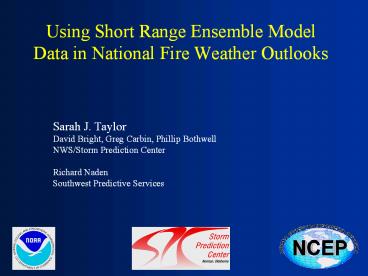Using Short Range Ensemble Model Data in National Fire Weather Outlooks
Title:
Using Short Range Ensemble Model Data in National Fire Weather Outlooks
Description:
... fire weather conditions combined with pre-existing fuel conditions forecast to occur ... Fire Weather Area. Outlooks based on forecasts of Relative ... –
Number of Views:75
Avg rating:3.0/5.0
Title: Using Short Range Ensemble Model Data in National Fire Weather Outlooks
1
Using Short Range Ensemble Model Data in National
Fire Weather Outlooks
Sarah J. Taylor David Bright, Greg Carbin,
Phillip Bothwell NWS/Storm Prediction
Center Richard Naden Southwest Predictive
Services
2
Overview
- SPC Fire Weather Program
- Use of short range ensemble forecasts (SREF)
- Case Studies
- July 8, 2003
- Recent Santa Ana event (October 25-31, 2003)
- Conclusions
3
SPC Fire Weather Program
- Fire weather forecasts began in 1998
- Purpose is to provide national fire weather
guidance to NWS, federal, state and local
government agencies - Product will outlook areas where critical fire
weather conditions combined with pre-existing
fuel conditions forecast to occur
4
SPC Fire Weather ProgramTypes of Outlooks
- Critical Fire Weather Areas
- Extremely Critical Fire Weather Areas
- Dry Thunderstorm Areas
- Issued for widespread dry lightning
5
Critical Fire Weather Area
- Outlooks based on forecasts of Relative Humidity,
maximum temperatures, sustained winds, and
pre-existing fuels - RH criteria varies by geography
- Temperatures must be greater than 60 F
- Sustained surface winds (10 meter) must be
greater than 20 mph - High Fire Danger Class Index, low 100/1000 hr
fuel moisture, long term drought
6
SPC Fire Weather Outlook Issued on Sunday October
26, 2003
7
Use of SREF output
- What is an ensemble forecast??
- Collection of different model solutions
- By changing the initial conditions, different
forecast solutions are created - SPC uses a 15 member ensemble from NCEP
- Consists of Eta, Eta KF, RSM models
- 48 km resolution
8
Use of SREF output
- Ensemble forecasts first applied operationally in
the 1990s - Studies have shown that ensembles are more
skillful than using 1 single model (Wandishin et
al, 2001, Bright and Mullen 2001) - SPC began using SREF operationally in 2002
9
Use of SREF output
- At the SPC, nearly 300 SREF products are
available - Relative Humidity
- Temperature
- Wind
- Fosberg Fire Weather Index
- Haines Index
- Convective precipitation
- Combinations of the above
10
Use of SREF outputStatistical Fields
- Mean and Spread
- Shows the average of the ensemble
- Will smooth small scale features
- Probability
- Indicate the percentage of ensemble members which
meet certain criteria - Extreme values
- Useful in predicting worst case events
11
- Fosberg Fire Weather Index Mean and Standard
Deviation Valid July 8 at 2100 UTC
12
Probability of Fosberg FWI greater than 75
Probability of Fosberg FWI greater than 50
13
Maximum Fosberg Fire Weather Index valid 18 UTC
July 8, 2003
14
Case Studies/Verification
- SPC Fosberg Fire Weather Index is used to verify
fire weather outlooks - Index is calculated with local objective analysis
scheme - Fosberg FWI greater than 50 is a threshold value
15
Case Studies (July 8, 2003)
- Forecast valid at 18 UTC on July 8
- Minimum RH with Mean Surface Wind
Sustained winds 20 kts or greater Minimum RH less
than 5
16
Maximum Fosberg Fire Weather Index valid 18 UTC
17
Observed maximum Fosberg FWI - valid 2100 UTC
July 8, 2003
18
Santa Ana Event October 2003
- Statewide loss of 20 lives
- 2600 houses with over 725,000 acres burned
- Monetary loss figures for the disaster are
estimated to be over two billion dollars
19
Satellite Loop
20
2055 UTC October 27, 2003
Image courtesy of Liam Gumley, Space Science and
Engineering Center, UW-Madison
21
(No Transcript)
22
Loop runs from 18 UTC October 26- 00 UTC October
27
23
Loop runs from 18 UTC October 26- 00 UTC October
27
24
Loop runs from 18 UTC October 26- 00 UTC October
27
25
Santa Ana Event October 2003
- SREF showed some skill
- Increased resolution of model would likely create
better forecasts - Fosberg Fire Weather Index did not verify well
for this event
26
Conclusions
- Short range ensemble forecasts will be used more
and more in the future - With increased experience and development,
ensembles will likely prove to be more useful
than a single deterministic model
27
Conclusions (Continued)
- Model resolution increases
- Better model physics
- Ongoing research in Initial Condition
perturbations - Increased ensemble spread
- Data mining tools and display
28
Acknowledgements
- The authors would like to thank Steve Weiss at
the Storm Prediction Center for his review and
Jason Levit for his assistance with case study
data
29
For more information
- Visit the SPC Fire Weather Page
- www.spc.noaa.gov/fire
- Page contains latest SPC fire outlooks, Eta
forecasts and latest surface analysis - Will include ensemble forecast guidance in the
future - This presentation is available online
- www.spc.noaa.gov/publications/taylor/srefams.html
- Email Sarah.Taylor_at_noaa.gov































